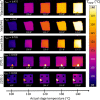Temperature-independent thermal radiation
- PMID: 31848248
- PMCID: PMC6936496
- DOI: 10.1073/pnas.1911244116
Temperature-independent thermal radiation
Abstract
Thermal emission is the process by which all objects at nonzero temperatures emit light and is well described by the Planck, Kirchhoff, and Stefan-Boltzmann laws. For most solids, the thermally emitted power increases monotonically with temperature in a one-to-one relationship that enables applications such as infrared imaging and noncontact thermometry. Here, we demonstrated ultrathin thermal emitters that violate this one-to-one relationship via the use of samarium nickel oxide (SmNiO3), a strongly correlated quantum material that undergoes a fully reversible, temperature-driven solid-state phase transition. The smooth and hysteresis-free nature of this unique insulator-to-metal phase transition enabled us to engineer the temperature dependence of emissivity to precisely cancel out the intrinsic blackbody profile described by the Stefan-Boltzmann law, for both heating and cooling. Our design results in temperature-independent thermally emitted power within the long-wave atmospheric transparency window (wavelengths of 8 to 14 µm), across a broad temperature range of ∼30 °C, centered around ∼120 °C. The ability to decouple temperature and thermal emission opens a gateway for controlling the visibility of objects to infrared cameras and, more broadly, opportunities for quantum materials in controlling heat transfer.
Keywords: heat transfer; phase transition; quantum materials; thermal emission; thermal radiation.
Conflict of interest statement
The authors declare no competing interest.
Figures




References
-
- Boyd R., Radiometry and the Detection of Optical Radiation (Wiley, 1983).
-
- Mink J., Handbook of Vibrational Spectroscopy (Wiley, 2006).
-
- Saunders P., On the effects of temperature dependence of spectral emissivity in industrial radiation thermometry. High Temp. High Press. 33, 599–610 (2001).
-
- Kaplan H., Practical Applications of Infrared Thermal Sensing and Imaging Equipment (SPIE, 2007).
-
- Vollmer M., Möllmann K.-P., Infrared Thermal Imaging (Wiley-VCH Verlag GmbH & Co. KGaA, 2017).
LinkOut - more resources
Full Text Sources

